A Simple Guide to Growing Banana Peppers
This guide will show you how to grow banana peppers. We'll cover everything from their history to how to take care of them. You'll also learn how to deal with pests and what to do with your peppers after you pick them.

What Are Banana Peppers?
Before you start growing, it's good to know a little about banana peppers. We'll talk about what they are and what they taste like. This will help you see how they're different from other peppers.
Where They Come From and How They Taste
The banana pepper is a type of Capsicum annuum . This is the same family as bell peppers, jalapeños, and cayenne peppers. They originally came from South America and North America, where they have been grown for thousands of years.
Christopher Columbus found them and brought them to Spain in the late 1400s. From there, they spread across Europe. Over time, new shapes and sizes of peppers developed, and modern banana peppers were created from these European types.
The classic banana pepper is also known as the yellow wax pepper. It gets its name because it's long, curved, and yellow like a banana. It has a mild, tangy, and slightly sweet taste .
A pepper's heat is measured in Scoville Heat Units (SHU). A sweet banana pepper is very mild, with a rating of 0 to 500 SHU. That's about the same as a pepperoncini and much less spicy than a jalapeño.
It can be confusing when you see "sweet" and "hot" banana peppers. They are often completely different types of peppers. This is a common mix-up that can be a problem for gardeners.
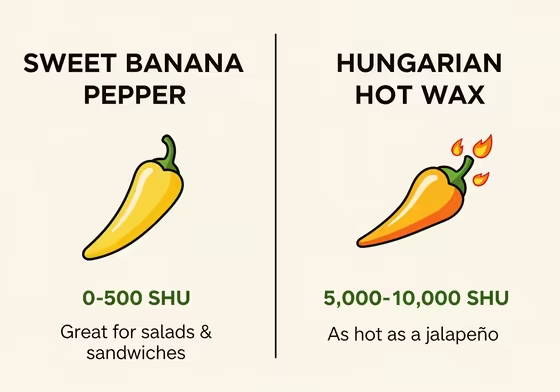
- Sweet Banana Peppers: These are the standard mild ones with 0-500 SHU. They're great for eating raw in salads or on sandwiches.
- "Hot" Banana Peppers: This name is tricky. It's usually just another name for the 'Hungarian Hot Wax' pepper, which is much spicier.
The 'Hungarian Hot Wax' pepper is much hotter, between 5,000 and 10,000 SHU. That's as hot as a jalapeño, maybe even hotter. So make sure you check the label when you buy seeds or plants to get what you really want.
Health Benefits and How to Use Them
Banana peppers are good for you and don't have many calories. A single medium pepper has only about 15 calories. They are also high in fiber, which helps with digestion and makes you feel full.
Banana peppers are healthy because of their vitamins and a compound called capsaicin.
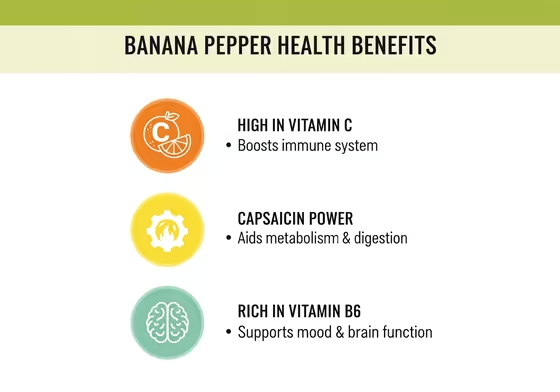
- High in Vitamin C: They are packed with Vitamin C , even more than an orange by weight. Vitamin C is great for your immune system and helps you heal.
- Helps Your Body: Capsaicin is what makes peppers spicy, but banana peppers only have a little. Even a small amount can help your body's metabolism and digestion.
- Good for Your Brain: They also have Vitamin B6, which helps your brain make chemicals that affect your mood. They also have Vitamin A for your eyes and other antioxidants.
You can use banana peppers in a lot of ways in the kitchen. Yes, you can eat them raw. That's one of the best ways to enjoy their crunchy texture.
They are often used raw on sandwiches or in salads. They are also famously pickled and sold in rings. You can also stuff them since their thick walls hold up well when baked.
Picking Your Banana Pepper Type
Choosing the right type of banana pepper is a big deal. It decides how hot your peppers will be and how big the plant gets. Here are some of the most common types you'll find.
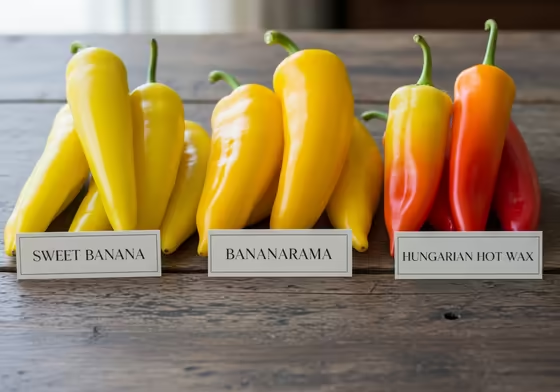
Popular Sweet (Mild) Varieties
- 'Sweet Banana': This is the most common kind and it is very mild. The peppers are 6 to 7 inches long and the plant produces a lot of them . It's best to wait until they turn orange or red for a sweeter, fruity taste .
- 'Long Sweet Yellow': This is usually just another name for the 'Sweet Banana' type.
- 'Bananarama': This one is great for growing in pots because the plant is smaller. The peppers are large , mild, and about 7 to 8 inches long.
Popular Hot Varieties
- 'Hot Banana': This can be confusing. It's often just a different name for 'Hungarian Hot Wax'.
- 'Hungarian Hot Wax': This is the most common "hot" type you'll find. It is much spicier than a sweet banana pepper, with a heat level similar to a jalapeño.
- 'Blazing Banana': This is a very large plant that can grow over 4 feet tall. The peppers are extra-long, around 7 to 9 inches.
Most banana pepper plants are pretty small. They usually grow about 18 to 24 inches tall. This makes them a good fit for containers or small gardens.
You can start your garden by buying live plants or by starting from seed.
- Buying Plants: The easiest way to start is by buying small plants from a nursery or store like Home Depot or Walmart. The downside is that they usually only sell one or two common types.
- Buying Seeds Online: If you start from seed, you have way more options to choose from. You can find seeds from places like RareSeeds.com (Baker Creek) or Pepper Joe's . This is cheaper and lets you pick the exact kind you want.
This table can help you pick the right type for your garden.
Table 1: Banana Pepper Variety Comparison
| Variety | Scoville Heat Units (SHU) | Flavor Profile | Average Fruit Size (Inches) | Average Plant Height (Inches) | Days to Maturity (from Transplant) |
|---|---|---|---|---|---|
| 'Sweet Banana' | 0-100 | Mild, tangy. Becomes sweeter when red. | 6-7 | 18-24 | 60-70 |
| 'Bananarama' (F1) | 0-500 | Mild, thick-walled, good for stuffing. | 7-8 | 24 | ~70-75 |
| 'Hot Banana' (F1) | 1,000-5,000 | Medium heat, slightly fruity. | 4-6 | 18-24 | 70-80 |
| 'Hungarian Hot Wax' | 5,000-10,000 | Hot; as hot or hotter than a jalapeño. | 5-6 | 18-24 | ~60-70 |
How to Plant Banana Peppers
This section explains how to plant your peppers, from starting seeds inside to moving them into the garden. Good timing and the right spot are key to success.
When and Where to Plant
Banana peppers need the sunniest spot in your garden. This is usually a spot that faces south. A little protection from strong winds is also helpful.
These plants need at least 6 to 8 hours of direct sun every day. If they don't get enough sun, they'll be weak and won't produce many peppers.
While they need a lot of sun, the type of sun can matter, especially in hot places. In hotter areas like the south, the afternoon sun can be too strong. Too much harsh sun can burn the peppers or make the plant drop its flowers .
So in hot climates, it's actually better to find a spot that gets morning sun and some light shade in the afternoon. This gives them the light they need without the stressful heat.
Banana peppers hate the cold, so you need to time your planting right. They can't handle any frost. Here's a simple timeline to follow.
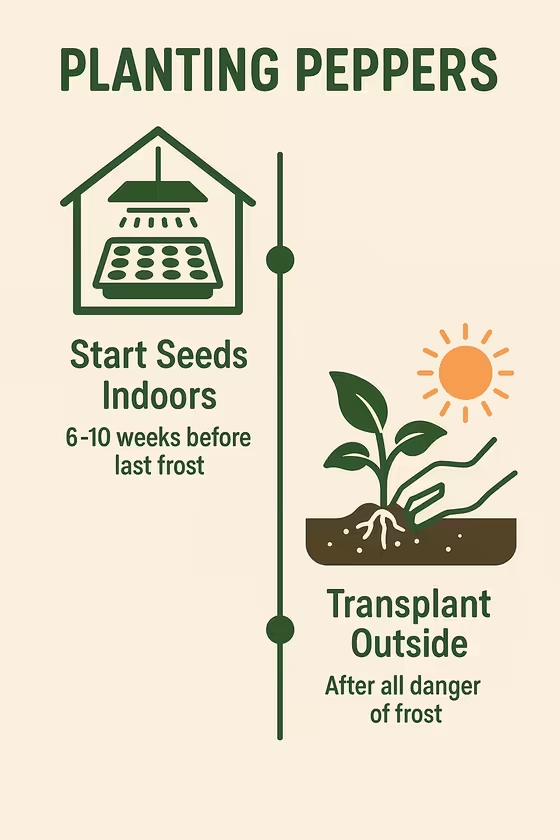
- Start Seeds Indoors: You need to start seeds inside about 6 to 10 weeks before your last frost date . Pepper seeds need warm soil (around 75°F) to sprout, so a heat mat helps a lot.
- Move Plants Outside: Only move your seedlings outside after all chance of frost is gone. The soil should be at least 60°F. Planting in cold soil will stunt their growth for good.
In most places, you can't plant peppers in the fall. They will die in the first frost before they make any fruit. In very hot places like Texas, you can have a "fall garden," but you have to plant it in the middle of summer , not in the fall.
Soil and Spacing
Peppers need loose, rich soil that drains well. If you have heavy clay soil, it can hold too much water and cause problems like root rot. It's best to add a lot of compost to your garden bed before planting.
The soil for pots is different from garden soil. Never use soil from your yard in a pot. It's too heavy and will pack down, which can drown the roots.
Use a good quality potting mix made for containers. Look for mixes that have perlite or vermiculite in them. These little white bits help with drainage and keep the soil light.
The standard advice is to space banana pepper plants 18 to 24 inches apart. This gives them enough room for air to move around.
Some gardeners plant them closer, about 12 to 18 inches apart. The plants can help support each other as they grow. This can also help with pollination.
The main benefit of planting them closer is that the leaves create a canopy. This shades the peppers and protects them from getting sunburned. This is a good trick for people gardening in very hot and sunny places.
Growing in Pots
Yes, banana peppers are great for growing in pots. Their smaller size makes them a perfect fit for a patio or balcony.
The size of the pot is really important. Use a container that is at least 3 to 5 gallons for each plant. A standard 5-gallon bucket with drainage holes works great.
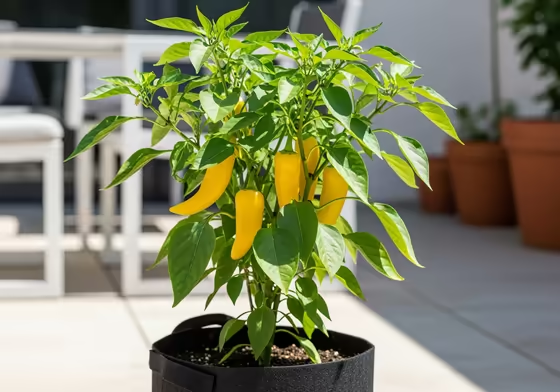
The pot also needs to be at least 10 to 12 inches deep. Don't try to plant more than one pepper plant in a 5-gallon pot.
Your pot must have drainage holes at the bottom. This lets extra water escape so the roots don't rot. Fabric grow bags and terracotta pots are good choices because they are porous and allow for great drainage.
Pots dry out much faster than garden beds. You'll need to check the soil every day . Water the plant whenever the top inch of soil feels dry.
When it's really hot (over 90°F), you might need to water once or even twice a day. This will keep the plant from wilting and dropping its flowers.
Growing Indoors
You can grow a banana pepper plant completely indoors, but you'll need some special gear. This is different from just bringing a plant inside for the winter. A 3 to 5-gallon pot is the right size to support a full-grown plant.
A sunny windowsill is not enough light for the plant to make flowers and fruit. A mature plant needs 14 to 16 hours of light every day from a good grow light to produce peppers.
Outside, wind and bees help pollinate the pepper flowers. Inside, you have to do their job . You can do this in a few ways.

- Fan: Put a small fan in the room. The moving air can be enough to shake the pollen loose.
- Tapping: Gently shake the plant or tap the flowers once a day to release the pollen.
- Hand Pollination: This is the best way. Use a small paintbrush or a cotton swab to move pollen from one part of the flower to another. You can also move it between different flowers on the plant.
Caring for Your Banana Pepper Plant
After your banana pepper plants are in the ground, they need regular care. This will help you get a healthy and large harvest. This section covers watering, feeding, and supporting your plant.
Water, Food, and Sun
Bad watering causes most pepper problems. Don't water on a fixed schedule, like every two days. Check the soil instead.
Stick your finger about an inch into the soil. If it's dry, it's time to water. If it's still damp, wait another day.
When you do water, water deeply . This encourages the roots to grow down deep, making the plant stronger. Try to water the soil at the base of the plant and keep the leaves dry to prevent diseases.
Remember, your plant needs at least 6-8 hours of direct sun every day.
Your plant's food needs change as it grows. You should use two different types of fertilizer during the season.

-
Stage 1: Before Flowers Appear
- The goal is to help the plant grow big and leafy .
- Use a balanced, all-purpose fertilizer that's higher in nitrogen. Something like a 5-5-5 fertilizer works well.
-
Stage 2: After Flowers Appear
- Now you want the plant to focus on making peppers, not leaves.
- Switch to a fertilizer that is lower in nitrogen and higher in phosphorus and potassium. A fertilizer for tomatoes is a good choice.
If you keep using a high-nitrogen fertilizer after flowers appear, the plant will make leaves instead of fruit. This can also cause the flowers to fall off before they can become peppers.
If your plants are in the ground, feed them with a slow-release fertilizer every 4 to 6 weeks. Potted plants need to be fed more often , about every 1 to 2 weeks with a watered-down liquid fertilizer.
Size, Support, and Pruning
Most banana pepper plants are small and grow to about 18 to 24 inches tall. Even though they are small, it's a good idea to give them some support.
A plant with a lot of peppers can get top-heavy. A strong wind could snap the main stem . Using a stake or a simple tomato cage will protect your plant and help you get more peppers.
Some gardeners "top" their pepper plants by cutting off the main growing tip to make them bushier. This is a debated topic. For banana peppers, it's best not to top them.
Experts say that large-fruited peppers like banana peppers don't benefit from topping and it can slow down your harvest. Since you're not topping them, you must give them support like a stake or cage.
The only pruning you should do is to remove the lowest leaves near the soil. This helps air move around the plant and prevents diseases.
Good and Bad Neighbor Plants
Companion planting means pairing plants that help each other out. This can help keep pests away and improve the health of your garden.
Here are some good neighbors for banana peppers:
- Herbs: Herbs with strong smells like basil , oregano, and rosemary can keep pests away.
- Onions and Garlic: The strong smell of onions, garlic, and chives can also repel pests like aphids.
- Flowers: Marigolds and nasturtiums are good choices. Nasturtiums can attract aphids , drawing them away from your peppers.
- Low-Growing Veggies: Lettuce, spinach, and carrots grow low to the ground and don't compete for sunlight.
Here are some plants to keep away from your banana peppers:
- Fennel: Fennel releases a chemical from its roots that can stop peppers from growing well.
- Brassicas: Broccoli, cabbage, and kale compete for the same nutrients as peppers.
- Pole Beans: Vining pole beans will grow tall and block the sun from your pepper plants.
- Other Nightshades: Planting potatoes, eggplant, and tomatoes too close is risky. They can all get the same pests and diseases, which could wipe out your entire crop.
This table gives a quick summary of what to plant near your peppers.
Table 2: Companion Planting Guide for Banana Peppers
| Plant | Recommended | Horticultural Reason |
|---|---|---|
| Basil, Oregano, Rosemary | YES | Strong scent deters common insect pests. |
| Onions, Garlic, Chives | YES | Pungent odor repels aphids and other pests. |
| Marigolds, Nasturtiums | YES | Nasturtiums act as a "trap crop" for aphids. Marigolds deter pests. |
| Lettuce, Spinach, Carrots | YES | Grow low to the ground; do not compete for sunlight. |
| Bush Beans | YES | Fix nitrogen in the soil; low-growing. |
| Fennel | NO (Antagonistic) | Allelopathic: Secretes chemicals that inhibit pepper growth and attract aphids. |
| Brassicas (Broccoli, Kale, Kohlrabi) | NO | Compete for the same soil nutrients; attract pests like flea beetles. |
| Pole Beans (Vining) | NO | Block sunlight and compete for nutrients. |
| Potatoes, Eggplant | NO (High Risk) | Share the same devastating pests and diseases (e.g., blight, potato beetles). |
| Apricot Tree | NO | Share a common fungal disease. |
Harvesting Your Peppers
Knowing when and how to pick your peppers is important. It affects the flavor of the pepper and how many peppers your plant will produce all season.
Timeline and Yield
Most banana pepper plants will give you peppers ready to pick in about 60 to 70 days after you plant them outside. If you want to let them ripen to red, it might take a little longer, around 65 to 80 days.
How many peppers you get depends on the plant and how well you care for it. A healthy 'Sweet Banana' plant is known to produce a lot. A typical plant will give you 25 to 50 peppers during the season.

With great care and a long growing season, a single plant might even produce over 100 peppers . Just know that you'll get fewer peppers if your plant is in a small pot.
How to Know When to Pick
You can tell when a banana pepper is ready by its size, texture, and color.
- Size: You can pick peppers when they are between 4 and 8 inches long. A good size to aim for is about 6 inches .
- Texture: A ready pepper should have firm, smooth skin with a nice shine. If the skin is soft or wrinkled, it's overripe.
- Technique: It's best to use scissors or pruners to cut the pepper from the plant. This avoids damaging the branch.
The color of the pepper when you pick it changes its taste.

- Yellow Stage: This is the best time to pick sweet banana peppers if you want them for pickling or sandwiches. The pepper will be sweet, tangy, and have the best crunch.
- Orange/Red Stage: If you leave it on the plant, it will turn from yellow to orange to red. For sweet types, this makes the pepper sweeter and more fruity, but also softer. For hot types like 'Hungarian Hot Wax', a red pepper will be at its hottest.
What to Do With Your Peppers
You'll probably end up with a lot of peppers at harvest time. This section covers how to store them for both the short and long term.
Freshly picked banana peppers can be stored for up to a week. They will last longer if you keep them in the crisper drawer of your fridge.
The two best ways to preserve your peppers for a long time are pickling and freezing.

- Pickling (Canning): This is the most popular way to save banana peppers. It makes the tangy rings you find on sandwiches and pizzas. You can find many simple recipes online for pickling using vinegar, sugar, and spices.
- Freezing: This is the easiest and fastest way to preserve peppers. It's great for peppers you plan to use in cooked dishes like sauces or soups. Just know that when you thaw them, they will be soft, not crunchy.
Besides pickling, banana peppers are great for cooking. A classic recipe is sausage-stuffed banana peppers. You can also slice them fresh onto pizza, fry them, or blend them into salsa or hot sauce.
Common Problems and Questions
This final section answers questions about how long pepper plants live and how to fix the most common problems you might run into.
How Long They Live and Winter Care
A lot of people wonder if their pepper plants will come back next year. Pepper plants are technically perennials, which means they can live for more than one year. But they are from tropical areas and can't survive frost.
So, in places with cold winters, they are grown as annuals and will die at the first frost. In a place without frost, or if you bring them inside, a pepper plant can live for 5, 10, or even more years .
You can keep your plant alive through the winter by bringing it indoors. This is called "overwintering." An overwintered plant will give you an earlier and bigger harvest the next year.
Here is a safe way to overwinter your plant:
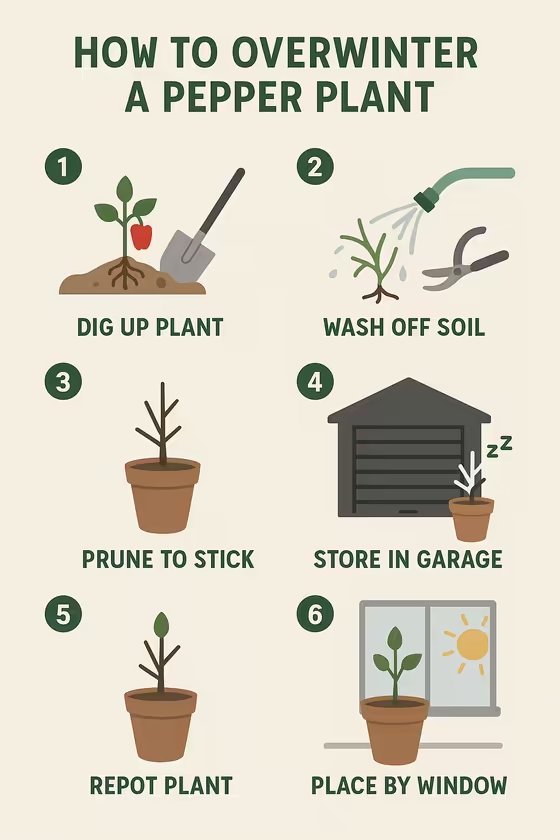
- Timing: Start this process before the first frost .
- Harvest & Dig: Pick all the peppers off the plant. Dig it up, keeping as much of the root ball as you can.
- Sanitize: This is a very important step. Use a hose to wash all the soil off the roots until they are bare. This gets rid of pests in the soil.
- Prune Hard: Cut the plant back so only the main stem and a few large branches are left. Remove all the leaves. The plant will look like a stick, which is what you want.
- Re-pot: Put the bare-root plant into a small pot with fresh, clean potting soil.
- Store: Keep the pot in a cool, dark, frost-free place like a garage or basement.
- Water: Water it very little, maybe once every 3 to 4 weeks . The goal is just to keep the roots from drying out completely.
- Re-awaken: About 6-8 weeks before the last spring frost, move the pot to a warm, sunny spot and start watering it again.
- Harden Off: Once it has new leaves, slowly get it used to being outside again before planting it back in the garden.
Fixing Common Problems
-
Yellowing Leaves:
This is a symptom with a few possible causes.
- Overwatering: This is the most common reason . The soil is too wet and the roots can't breathe.
- Nutrient Deficiency: If only the lower, older leaves are yellow, the plant probably needs nitrogen.
- Pests: Check under the leaves for tiny bugs like aphids or spider mites.
-
Blossom End Rot:
- This is when a dark, sunken spot forms on the bottom of the pepper. It is not a disease.
- It's caused by a problem with how the plant uses calcium. The number one trigger is inconsistent watering . Letting the soil get bone-dry and then soaking it messes up how the plant moves nutrients.
- To fix it, remove the bad peppers. Then, make sure you water the plant evenly and deeply. Using mulch can help keep the soil moisture consistent.

-
Pest Problems:
- Aphids are the most common pest. You can usually get rid of them with a strong spray of water from a hose or by using insecticidal soap.
-
Small or No Fruit:
- This is often caused by heat. If temperatures get above 90°F , the plant can get stressed and drop its flowers before they turn into peppers.
- To help, you can use a shade cloth to protect the plant during the hottest part of the day. A weak plant that isn't getting enough sun, water, or food will also struggle to make fruit.
This table is a quick guide for fixing common problems.
Table 3: Banana Pepper Troubleshooting Guide (Diagnostic Tool)
| Symptom | Probable Cause | Expert Solution |
|---|---|---|
| Yellowing (lower, older leaves only) | Nitrogen Deficiency | Apply a balanced, all-purpose fertilizer (e.g., 5-5-5). |
| Yellowing (all over plant), wet soil | Overwatering / Root Rot | Stop watering immediately. Allow soil to dry. Ensure container has drainage. |
| Dark, sunken, leathery patch on bottom of fruit | Blossom End Rot (BER) | Cause: Inconsistent watering. Solution: Remove affected fruit. Apply a 3-inch layer of mulch and maintain even , deep watering. |
| Flowers fall off, no fruit sets | Heat Stress | Cause: Temperatures consistently above 90°F. Solution: Provide afternoon shade with a shade cloth. Ensure consistent watering. |
| New leaves are puckered, crinkled; sticky residue | Aphids | Check the undersides of leaves. Spray plant with a strong blast of water or use insecticidal soap. |
| Small, deformed fruit with few seeds | Poor Pollination | Cause: Lack of wind/agitation, or extreme temperatures. Solution: Gently shake plants daily to distribute pollen. (Indoors: Hand-pollinate). |
| Stunted plant, few fruits, pale leaves | Lack of Sun / Nutrients | Cause: Less than 6 hours of direct sun. Solution: Move container to a sunnier location. Fertilize with a balanced liquid feed. |